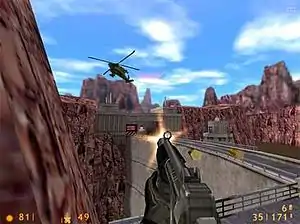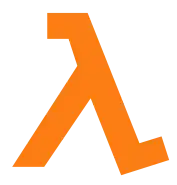GoldSrc
GoldSrc is a proprietary game engine that was developed by Valve in 1998, and was first showcased in the first-person shooter game Half-Life. Elements of GoldSrc are based on a heavily modified version of id Software's Quake engine. Following Half-Life's release, the engine powered future games developed by or with oversight from Valve, including Half-Life's expansions, Day of Defeat, and multiple games in the Counter-Strike series.
 | |
| Other names | Goldsource |
|---|---|
| Developer(s) | Valve |
| Written in | C, C++ |
| Predecessor | Quake engine, Quake II engine |
| Successor | Source Engine |
| License | Proprietary |
GoldSrc was succeeded by the Source engine in 2004, with the release of Counter-Strike: Source and Half-Life 2.
However, Valve continues to support the engine with periodic updates.
Development
The basis of GoldSrc is the engine used in the video game Quake, albeit with heavy modification by Valve. While the engine served as the basis for GoldSrc, Gabe Newell has stated that a majority of the code used in the engine was created by Valve themselves. GoldSrc's artificial intelligence systems, for example, were essentially made from scratch.[1] The engine also reuses code from other games in the Quake series, including QuakeWorld and Quake II, but this reuse is minimal in comparison to that of the original Quake.[2] In 1997, Valve hired Ben Morris and acquired Worldcraft, a tool for creating custom Quake maps.[3] The tool was later renamed to Valve Hammer Editor and became the official mapping tool for GoldSrc. The engine supports skeletal animation, which allowed for more realistic body kinematics and facial expression animations than most other engines at the time of release.[4]
Prior to the creation of the Source engine, the GoldSrc engine had no real title and was simply called "The Half-Life engine". Once Source was created, Valve forked the code from the Half-Life engine to make the Source engine. This created two main engine branches, each used for different purposes. One was titled "GoldSrc" and the other "Src". Internally, any games using the first variant were referred to as "Goldsource" in order to differentiate the two branches. Eventually, it became something of a moniker for the engine and was adopted as the official title externally.[5]
Valve released versions of the GoldSrc engine for OS X and Linux in 2013, eventually porting all of their first-party games utilizing the engine to the platforms by the end of the year.[6][7]
History
Half-Life series
Half-Life was the debut title of both GoldSrc and Valve. It went on to receive critical acclaim, winning over fifty PC Game of the Year awards.[8] The game was followed up with two expansions, Half-Life: Opposing Force and Half-Life: Blue Shift, both of which ran GoldSrc and were developed by Gearbox Software.[9][10] Half-Life: Decay, an expansion pack for Half-Life only released on PlayStation 2, was released in 2001 alongside Half-Life's debut on the platform.[11] Unlike other games in the series, it never received an official version for Windows, however an unofficial version of the game was released by independent developers in 2008.[12][13][14] Half-Life: Decay was the final iteration in the Half-Life series to run on GoldSrc, with all future entries in the series using the Source and Source 2 engines.[15][16]
Other Valve games
Valve developed several games using the GoldSrc engine, many of which were based on original user-made modifications of Half-Life. Team Fortress Classic, released officially by Valve in 1999, was one of such games (based on an older Quake mod, Team Fortress). Counter-Strike, Ricochet, and Day of Defeat were also originally modifications, the rights to which were purchased by Valve.[17][18] Counter-Strike evolved into its own series with the release of Counter-Strike: Condition Zero in 2004, and while Counter-Strike: Source ran on the Source engine, further games in the series still used GoldSrc.[19] Counter-Strike Neo, Counter-Strike Online, and Counter-Strike Nexon: Zombies, released in 2005, 2008, and 2014 respectively, utilized GoldSrc as their basis, despite the development of the Source engine having been completed and the first version released.
Third-party games and modifications
The GoldSrc engine was also used for a variety of third-party games and modifications not directly developed by Valve. Rewolf Software used the engine for the game Gunman Chronicles in 2000, and the PC version of James Bond 007: Nightfire was developed by Gearbox Software using a modified version of GoldSrc in 2002.[20][21][22]
Unofficial, community-made modifications of GoldSrc have also been produced. Notable games include Natural Selection, Cry of Fear and Sven Co-op, with Valve's Team Fortress Classic, Counter-Strike, and Day of Defeat all being based on GoldSrc mods of the same names. Cry of Fear and Sven Co-op have since been released for free as standalone games on Steam.
Games using GoldSrc
| Year | Title | Developer(s) | Publisher(s) |
|---|---|---|---|
| 1998 | Half-Life | Valve | Sierra Entertainment, Valve (digital) |
| 1999 | Half-Life: Opposing Force | Gearbox, Valve | |
| Team Fortress Classic | Valve | Valve, Sierra Entertainment (digital) | |
| Sven Co-op | Sven Co-op team | Sven Co-op team | |
| 2000 | Counter-Strike | Valve | Sierra Entertainment |
| Gunman Chronicles | Rewolf Entertainment | Sierra Entertainment | |
| Ricochet | Valve | Valve | |
| 2001 | Deathmatch Classic | ||
| Half-Life: Blue Shift | Gearbox, Valve | Sierra Entertainment, Valve (digital) | |
| Half-Life: Decay | Gearbox | Sierra Entertainment | |
| 2002 | James Bond 007: Nightfire | Eurocom, Gearbox | Electronic Arts |
| 2003 | Day of Defeat | Valve | Activision, Valve (digital) |
| Counter-Strike Neo | Namco | Namco | |
| 2004 | Counter-Strike: Condition Zero | Valve, Ritual Entertainment, Gearbox, Turtle Rock Studios | Sierra Entertainment, Valve (digital) |
| 2008 | Counter-Strike Online 1 | Valve, Nexon | Nexon |
| 2014 | Counter-Strike Nexon: Studio | Valve, Nexon | Nexon |
References
- Bokitch, Chris (1 August 2002). "Half-Life's Code Basis". Valve. Archived from the original on 1 March 2007. Retrieved 12 February 2011.
- Newell, Gabe (1999). "Half Life: Interview With Gabe Newell". GameSpot UK. Archived from the original on 23 July 2001. Retrieved 22 March 2011.
- "Valve Press Release". Valve. Retrieved 12 May 2010.
- "Modeling and Animating for Half-Life (Interactive Graphics Lecture 22 notes, Professor Denis Zorn)" (PDF). NYU Math Dept. Retrieved 13 January 2019.
- Johnson, Erik (1 September 2005). "Talk:Erik Johnson". Valve Developer Community. Retrieved 12 February 2011.
- "Counter-Strike 1.6 Beta released". Valve. 28 January 2013. Retrieved 22 February 2014.
- McWhertor, Michael (25 January 2013). "Valve releases original Half-Life for Mac and Linux". Polygon. Archived from the original on 17 December 2013. Retrieved 25 January 2013.
- "Awards and Honors". Valve. Archived from the original on 8 January 2014. Retrieved 23 February 2014.
- "Half-Life Expands". IGN. 15 April 1999. Archived from the original on 9 November 2012. Retrieved 23 February 2014.
- Trueman, Doug (30 August 2000). "DC Half-Life Includes Blue Shift". GameSpot. Archived from the original on 7 November 2012. Retrieved 23 February 2014.
- C. Perry, Douglass; Zdyrko, Dave; Smith, David (19 September 2001). "Half-Life Preview". IGN. Archived from the original on 8 November 2012. Retrieved 23 February 2014.
- "Half-Life: Decay - Valve Developer Community". developer.valvesoftware.com. Valve. 6 September 2011. Retrieved 19 July 2016.
- Dzhura, Vyacheslav; Zhatov, Denis. "PC:Decay". decay.half-lifecreations.com. Dimension Force. Retrieved 14 July 2016.
- Hoaxer. "ModDB Half-Life Decay". ModDB. ModDB. Retrieved 14 July 2016.
- Butts, Steve (8 May 2003). "Half-Life 2 Preview". IGN. IGN Entertainment. Archived from the original on 11 November 2013. Retrieved 23 February 2014.
- Machkovech, Sam (22 January 2020). "Valve opens up about Half-Life: Alyx, Source 2 engine on Reddit". Ars Technica. Retrieved 23 October 2020.
- Wolfe, Clayton (22 November 2000). "Counter-Strike". IGN. Archived from the original on 25 October 2012. Retrieved 24 February 2014.
- "Valve signs with Activision, exclusive Day of Defeat screens". GameSpot. 4 April 2003. Archived from the original on 25 February 2014. Retrieved 25 February 2014.
The first Valve game to be released through Activision will be Day of Defeat, a Half-Life-powered first-person shooter set in World War II.
- Kasavin, Greg (25 March 2002). "Counter-Strike: Condition Zero Preview". GameSpot. Archived from the original on 25 February 2014. Retrieved 24 February 2014.
- Varanini, Giancarlo (1 September 2000). "Sierra Unveils Gunman Chronicles". GameSpot. Archived from the original on 26 February 2014. Retrieved 25 February 2014.
- Blevins, Tal (4 December 2000). "Gunman Chronicles". GameSpot. Archived from the original on 26 February 2014. Retrieved 26 February 2014.
- Ajami, Amer (18 July 2002). "James Bond 007: NightFire Preview". GameSpot. Archived from the original on 25 February 2014. Retrieved 24 February 2014.

